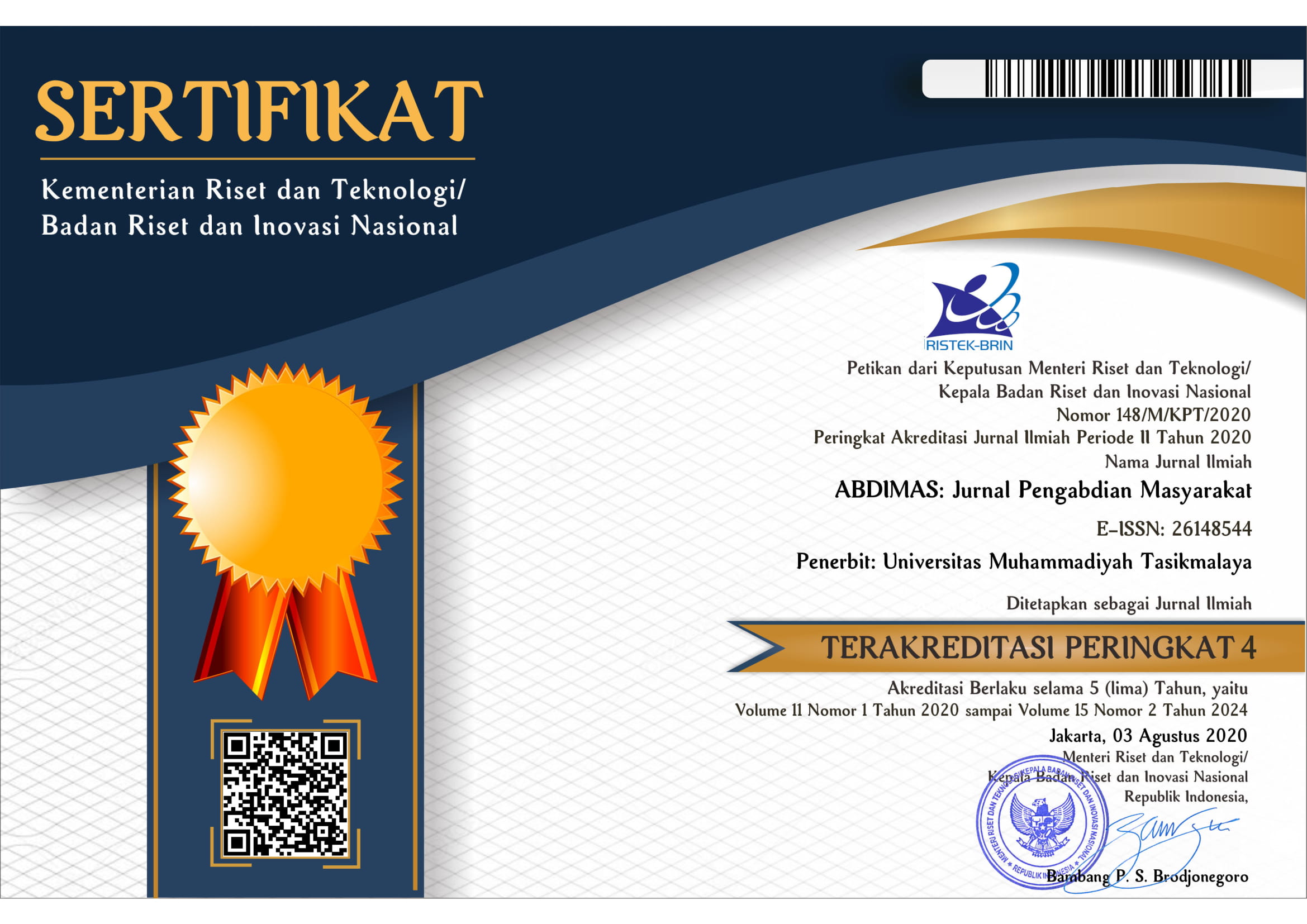Training on Making Aromatherapy Candles for Body Health for Housewives in the Joso Triyagan Area RT 01 / RW 01, Mojolaban, Sukoharjo.
DOI:
https://doi.org/10.35568/abdimas.v5i2.2580Keywords:
Aromatherapy Candles, Body Health, HousewivesAbstract
Mosquitoes are one of the causes of community problems because they can cause various diseases and interfere with comfort. Mosquitoes can be caused due to lack of environmental hygiene in the community. Nowadays, many people are afraid to use ready-made mosquito repellent products that have been made and issued by certain factories or industries. The chemical content contained in these preparations is the reason why people are looking for other alternatives to make mosquito repellents using natural ingredients that are safer. One of the efforts to prevent and control mosquito attacks is to use air fresheners in the form of aromatherapy gels and candles. Making aromatherapy candles is quite easy and the ingredients are very affordable so that people can make their own. The purpose of this activity is to increase public awareness of the importance of maintaining a clean environment to create health for the family as well as training in making aromatherapy candles with natural ingredients, producing products that can be used alone or developed into a home industry. This activity was carried out by providing environmental hygiene education and workshops on making aromatherapy candles as an alternative to mosquito repellent. The results obtained are an increase in people's understanding of environmental hygiene. In addition, aromatherapy has benefits for body health and then aromatherapy candles are produced as mosquito repellents whose production can be developed on a household industrial scale in the Joso Triyagan area RT 01 / RW 01, Mojolaban, Sukoharjo.
Downloads
References
Boesri, H. B., Heriyanto, B., Susanti, L., & Handayani, S. W. (2015). Uji repelen (daya tolak) beberapa ekstrak tumbuhan terhadap gigitan nyamuk Aedes aegypti vektor demam berdarah dengue. Vektora: Jurnal Vektor dan Reservoir Penyakit, 7(2), 79-84.
Diaz, J. H. (2016). Chemical and plant-based insect repellents: efficacy, safety, and toxicity. Wilderness & Environmental Medicine, 27(1), 153-163.
Fitriani, D., Widiyati, E., & Trihadi, B. (2020). Pelatihan Pembuatan Sabun Mandi Padat Dengan Penambahan Minyak Atsiri Jeruk Kalamansi Sebagai Aromaterapi Di Smpit Khairunnas Bengkulu. Jurnal Pengabdian Al-Ikhlas Universitas Islam Kalimantan Muhammad Arsyad Al Banjary, 6(1).
Kementrian Kesehatan. 2016. Situasi penyakit demam berdarah di Indonesia tahun 2017. Jakarta: Kementrian Kesehatan RI; 2016.
Minah, F.N., Tri P., Siswi A., Musayyaroh, Rini K., Elvianto, Istnaeny H., dan Endah K.R. (2017). Pembuatan Lilin Aromaterapi Berbasis Bahan Alami. Jurnal Industri Inovatif, 1(7), 29-34
Moore, E. L., Scott, M. A., Rodriguez, S. D., Mitra, S., Vulcan, J., Cordova, J. J.,et al & Hansen, I. A. (2018). An online survey of personal mosquito-repellent strategies. PeerJ, 6, e5151.
Musfanto, C. P., Sumampouw, O. J., & Pinontoan, O. R. (2019). Sebaran Kejadian Demam Berdarah Dengue di Kota Manado Tahun 2016-2018. KESMAS, 8(6).
Rianti, E. D. D. (2017). Mekanisme Paparan Obat Anti Nyamuk Elektrik dan Obat Anti Nyamuk Bakar terhadap Gambaran Paru Tikus. Inovasi, 19(2), 58-68.
Ridha, M. R. (2013). Hubungan Kondisi Lingkungan dan Kontainer dengan Keberadaan Jentik Nyamuk Aedes aegypti di Daerah Endemis Demam Berdarah Dengue di Kota Banjarbaru. Jurnal Epidemiologi dan Penyakit Bersumber Binatang. Vol 4 (23).133- 137.
Rodriguez, S. D., Drake, L. L., Price, D. P., Hammond, J. I., & Hansen, I. A. (2015). The efficacy of some commercially available insect repellents for Aedes aegypti (Diptera: Culicidae) and Aedes albopictus (Diptera: Culicidae). Journal of Insect Science, 15(1), 140.
Soonwera, M., & Phasomkusolsil, S. (2015). Efficacy of Thai herbal essential oils as green repellent against mosquito vectors. Acta Tropica, 142, 127-130.
Ustiawaty, J., Pertiwi, A.D, Aini. (2020). Upaya Pencegahan Penyakit Demam Berdarah Melalui Pemberantasan Nyamuk Aedes aegypti. Jurnal Pengabdian Magister Pendidikan IPA. 3(2):200-204.
Waris, R., Amin, A., & Najib, A. (2020). PELATIHAN PEMBUATAN MINYAK AROMATERAPI PADDINGING. JCES (Journal of Character Education Society), 3(2), 175-186.
World Health Organization. Dengue Bulletin. 2016. Available from: https://www. https://apps.who.int/iris/handle/10665/255696.














